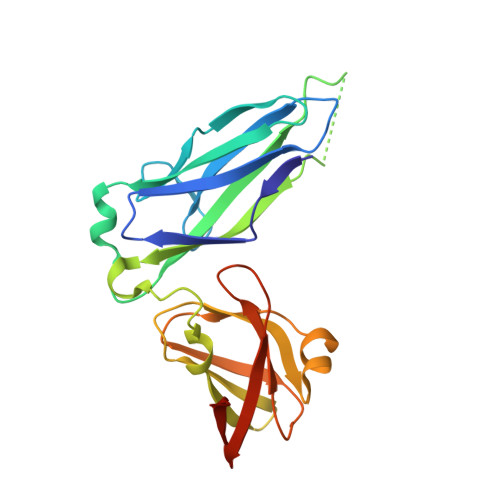The Escherichia coli P and Type 1 Pilus Assembly Chaperones PapD and FimC Are Monomeric in Solution.
Sarowar, S., Hu, O.J., Werneburg, G.T., Thanassi, D.G., Li, H.(2016) J Bacteriol 198: 2360-2369
- PubMed: 27353649
- DOI: https://doi.org/10.1128/JB.00366-16
- Primary Citation of Related Structures:
5K93 - PubMed Abstract:
The chaperone/usher pathway is used by Gram-negative bacteria to assemble adhesive surface structures known as pili or fimbriae. Uropathogenic strains of Escherichia coli use this pathway to assemble P and type 1 pili, which facilitate colonization of the kidney and bladder, respectively. Pilus assembly requires a periplasmic chaperone and outer membrane protein termed the usher. The chaperone allows folding of pilus subunits and escorts the subunits to the usher for polymerization into pili and secretion to the cell surface. Based on previous structures of mutant versions of the P pilus chaperone PapD, it was suggested that the chaperone dimerizes in the periplasm as a self-capping mechanism. Such dimerization is counterintuitive because the chaperone G1 strand, important for chaperone-subunit interaction, is buried at the dimer interface. Here, we show that the wild-type PapD chaperone also forms a dimer in the crystal lattice; however, the dimer interface is different from the previously solved structures. In contrast to the crystal structures, we found that both PapD and the type 1 pilus chaperone, FimC, are monomeric in solution. Our findings indicate that pilus chaperones do not sequester their G1 β-strand by forming a dimer. Instead, the chaperones may expose their G1 strand for facile interaction with pilus subunits. We also found that the type 1 pilus adhesin, FimH, is flexible in solution while in complex with its chaperone, whereas the P pilus adhesin, PapGII, is rigid. Our study clarifies a crucial step in pilus biogenesis and reveals pilus-specific differences that may relate to biological function.
Organizational Affiliation:
Department of Biochemistry and Cell Biology, Stony Brook University, Stonybrook, New York, USA Biology Department, Brookhaven National Laboratory, Stonybrook, New York, USA.














